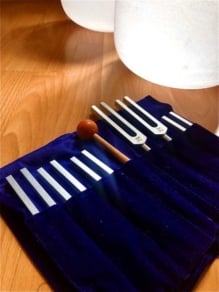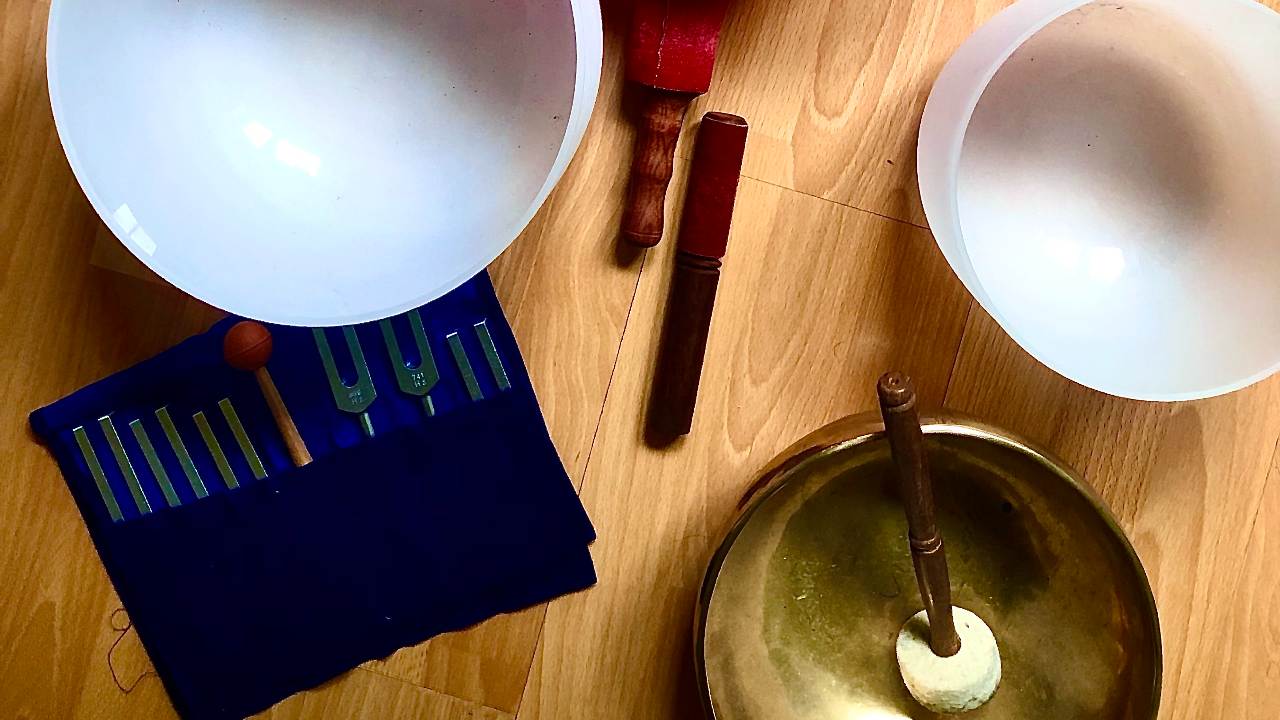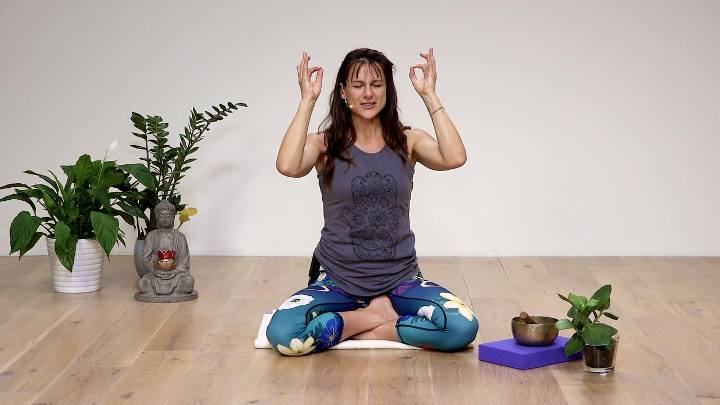Even if you don’t realise, you’ve probably already felt how powerfully healing sound can be. If you have a favourite song that makes you feel happy, that’s the power of sound; if you’ve ever danced until your feet were sore, that’s the power of sound; if there’s a piece of music that conjures up memories, that’s the power of sound.
Sound is all around us, and whether we know it or not, it’s always affecting how we feel. Which is why the healing power of sound is something yogis have been aware of for thousands of years. Today, sound healing and sound baths are a popular way to experience the many benefits of specific tones and instruments.
A sound bath is simply a deeply relaxing experience where you lie down on a mat or blanket, with as many cushions or props as you need to feel comfortable, and then ‘bathed’ in the sound vibrations.
Sound healing is very much the same, although sound healing sessions can be done as a 1-2-1 therapy with a practitioner and may also include guided relaxation and visualisation. Instruments used vary from gongs to alchemical crystal bowls, Tibetan bowls, bells, rain sticks, drums, flutes, Koshi chimes, Kenari shakers, and tuning forks tuned to specific frequencies. When you head out to a sound therapy experience, allow yourself to let go and be open to the practice, and you could experience one of the many benefits for your physical and mental health including:
- Reduced stress
- Improved sleep
- Lower blood pressure
- Reduced pain
- Reduced anxiety
- Lower cholesterol levels
- Fewer mood swings
- More balanced hormones
- Greater sense of overall wellbeing
But do you know the reason why sound healing is so effective?
Read on for the science and benefits behind sound healing and sound baths, and why they’re so popular today.
Pause for a moment and listen. What can you hear? Perhaps the hum of the refrigerator, a song on the radio, aeroplanes, wind rustling through leaves? From the most audible sounds closest to you right now, to the muffled sounds you can barely hear, all of those frequencies are having an impact on the mind and body.
We’ve never been surrounded by sound as much as we are today. Beyond the positive and uplifting sounds of singing and music, there’s also ‘noise pollution’, which researchers say is one of the leading causes of health issues worldwide. A 2021 study estimated that people living close to busy roads were more likely to experience high cortisol (the ‘stress hormone’) levels, hypertension or heart disease, and up to 40 million people in the US suffer from a hearing impairment due to excessive noise exposure.
It doesn’t have to be loud and disturbing noises that affect us however. The ‘bing’ and ‘beep’ of notifications can also increase stress levels. When our phones or computers make a sound to notify us of a message, our brains might release dopamine – the ‘motivation’ and ‘desire’ hormone – but they can also release cortisol, which, in excess, is detrimental to health.
In a world with so much noise, it’s more important than ever to be intentional and conscious about how we use sound and how we interact with it, which is where sound healing comes in.
An ancient art and science
Healing with sound has existed for thousands of years. The Ancient Egyptians used musical incantations to help heal the sick, whilst the ancient yogic text the Samaveda contains chants and hymns and was recited in a specific harmony. Greek physicians used musical instruments to heal patients, using the power of vibration to promote healthy digestion, sleep and emotional disturbances.
Vibration really is a key word when it comes to sound healing, because all sound is made up of vibration. All sounds are made up of waves produced by the vibrations of material objects. If you clap your hands together, this creates a vibration, which we hear as soundwaves and frequencies. If you strum a guitar, the vibration of the strings sends out waves, heard as frequencies. These vibrations are transmitted through the air, and when they reach our ears they’re converted to electrical impulses in the brain, which we interpret as sound. It’s these specific frequencies that sound healers often use in sessions in order to help balance mind-body health.
Good vibrations

Specific frequencies can be used to help optimise the body’s organs, as well as to elicit certain brainwaves and emotional states. Autoimmune disease specialist Christina Sessmus says; “Humans have an optimal frequency, as does everything else in the universe, that occurs when each of the cells in our body vibrates at the frequency it was designed to. (“The Vibrational Frequencies of the Human Body | Biohackers …”) Bruce Tainio, famous researcher and developer of Tainio Technology found that a healthy body resonates at a frequency of 62-72 MHz, (MHz takes 1 ‘hz’ and multiplies it by a million) and when your frequency drops to 58 MHz, that is when disease starts. Bacteria, viruses, and disease each have their own, low frequency that influence your energy field”.
If you’ve heard the phrases ‘good vibes’ and ‘bad vibes’, this is essentially what these sound specialists are referring to. When our bodies and minds are vibrating at a healthy level, we generally feel well inside and out. If we spend time in environments or with people who drain us or bring us ‘down’ however, this can lower our vibrational frequency and leave us more susceptible to illness or mood issues. Using sound-based vibration is one of the key ways sound healing can help reharmonise and rebalance our body and emotion. In fact, this is already used in medicine today to help reduce pain for those with arthritis, menstrual pain, and postoperative pain. Even medical ultrasound uses vibrations, waves and echoes, to produce images of structures (and babies!) within the body.
Read more: Mantra and vibration – A divine path to union
Healing frequencies for emotions, organs and chakras
Now that we know a little about the science of sound, it’s easier to understand how it can be so beneficial. Certain sound waves can encourage our brain to elicit certain brain waves that can help us feel relaxed, alert, focused, and even aid us in entering a meditative state. When our brain is in a relaxed and balanced state, it stimulates the parasympathetic nervous system (the ‘rest and digest’ system) helping the body’s organs and tissues rest, heal and regenerate.
As well as physical health, sound healing is also used to release ‘blocked’ energy from the subtle energy channels, which restores balance to our emotions too. Specific frequencies are linked to specific patterns in numerology and geometry, and are said to have specific effects on the body and mind, such as:
- 174 Hz relieves pain and stress
- 285 Hz heals tissues and organs
- 396 Hz liberates the listener from fear and guilt
- 417 Hz facilitates change
- 528 Hz for transformation and DNA repair (known as the ‘miracle frequency’)
- 639 Hz reconnects relationships
- 741 Hz helps provide solutions and self-expression
- 852 Hz brings the listener back to a ‘spiritual order’
- 963 HZ encourages a sense of oneness and unity
To experience the benefits of different frequencies, you can search for Binaural Beats online, which includes frequencies to elicit brainwaves like Delta for sleeping, Theta meditation, Alpha for reduced anxiety and more positivity, Beta for increased focus and problem solving, and frequencies to help improve motivation and learning too.
TCM – toning and healing sounds
As well as frequencies, health systems like Traditional Chinese Medicine (TCM) have used healing sounds and a method known as ‘toning’ to bring the body and mind back into balance. Toning uses the voice, and includes healing sounds such as:
- Lungs: “Ssssssssss”
- Kidneys: “Choooooooo”
- Liver: “Shhhhhhhhhh”
- Heart & Small Intestine: “Haaaaaaaa”
- Spleen & Pancreas: “Whoooooo”
- Triple Burner / San Jiao (the core or trunk of the body): “Herrrrrrrrrrr”
Chakras and Bija mantras
Sound healing also works directly with the Chakras. Imagine the 7 main energy wheels located up the spine, starting from the tailbone and ending just above the crown of the head. Each wheel needs to be ‘spinning’ optimally in order to help the body vibrate at a healthy frequency. If one wheel is ‘stuck’ or ‘blocked’, this lowers the body’s frequency and causes disharmony, dis-ease and maybe even disease. The 7 chakra points correspond to specific organs and hormones within the body, and it’s very common to have at least one or two chakra points that are blocked or not functioning optimally. Sound is one of the most powerful ways to help balance the chakras.
Each chakra has a corresponding mantra to help bring it back to balance, known a bija mantra or ‘seed’ mantra.
- Muladhara / Root Chakra: Bija mantra – “lam” (pronounced ‘lum’)
- Svadhisthana / Sacral Chakra: Bija Mantra- “vam” (pronounced ‘vum’)
- Manipura / Solar Plexus Chakra: Bija mantra – “ram” (pronounced ‘rum’)
- Anahata / Heart Chakra: Bija mantra – “yam” (pronounced ‘yum’)
- Vishuddhi / Throat Chakra: Bija mantra: “ham” (pronounced ‘hum’)
- Ajna / Third Eye Chakra: Bija mantra: “OM”
- Sahasrara / Crown Chakra: Bija mantra: Sahasrara Chakra is traditionally considered to be beyond all sound, but many people also use the mantra “OM” for this chakra.
Try this free class – Vocal toning the chakras with Tashi
Tashi shares her love for exploring voice work and vibration to find a calm and balanced state of body and mind. Perfect for those who are starting to use voice-work in their practice or teaching and is an open invitation to simply explore a range of sounds.
So, gather up your comfiest blankets and cushions, find your nearest sound healing practitioner (or experience an online sound healing experience from the comfort of your own home) and let yourself receive the healing benefits of sound.


